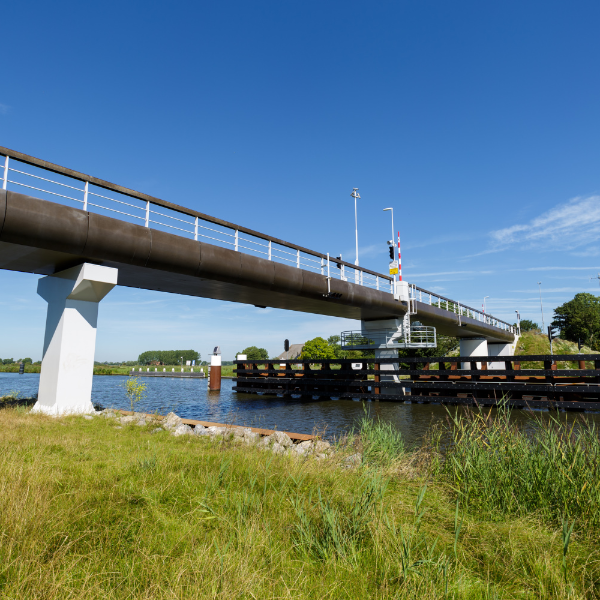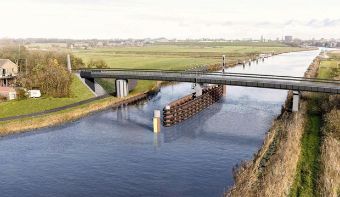Fixed bridges

Fixed bridges
Bridges are often called works of art for a reason; they are crucial structures that contribute to the economic growth, social cohesion and overall quality of life of societies worldwide. Bridges can be designed in a sober and purposeful manner, but they are often technical and architectural marvels that capture the imagination.
In our commitment to a more sustainable world, we return to materials of the past, but in a contemporary look. Timber, geopolymers (as used in the Pantheon in Rome) and natural fibres are re-emerging as less environmentally damaging alternatives to traditional construction methods.
With the combination of ancient knowledge and modern technologies, we continue to build bridges, not only across our waterways, but also towards a future where respect for the past goes hand in hand with innovation for tomorrow. Witteveen+Bos’ strength lies in collaboration and uniting ambitious goals for complex challenges.
In the field of bridge building, Witteveen+Bos contributes to improving the mobility, accessibility and quality of life of cities and regions, while striving for innovative and sustainable solutions. We work with leading architects in designing bridges. Although we do not employ architects ourselves, we consciously choose to select the right partner for each project. This approach has led to impressive results in the field of bridge building, with innovation and sustainability at its core, such as:
Sustainability and innovations
In terms of sustainability, we are actively working on innovative production methods, such as 3D-printed concrete, geopolymers, fibre-reinforced concrete, thermoplastics, the use of recycled and biobased raw materials and composites. It is important for our designs to be implemented in a sustainable manner. In doing so, we choose the optimal solution with the lowest possible carbon footprint.
Ecology and biodiversity
Our ecosystems are more important than ever before. Ecology and biodiversity are increasingly important evaluation criteria for awarding a project. Thanks to nature-inclusive design, for example, we submitted the winning bid within the Gelderegroen consortium for the ViA15 DBFM project. This design is a model for the integration of flora and fauna.
Circular and climate-neutral
The detachability of structures is an important key to enabling high-quality reuse with no loss of value. Witteveen+Bos bases its designs on the principles of IFD (industrial, flexible, demountable) to make this possible. Among other things, Witteveen+Bos has developed a measurement method that can be used to assess the degree of detachability of civil engineering structures. This is how we contribute to a sustainable, biobased and circular approach to designing the bridges of the future. Standardising the building components reduces replacement costs and increases opportunities for reuse. By using a materials passport and our own +Circular Design Tool, we have insight into the level of circularity during every phase of the project.
Monitoring
To effectively maintain and optimise the bridges of the future and our current surface area, we use advanced methods such as digital twin models and structural health monitoring (SHM). At Witteveen+Bos, we have our own monitoring equipment and we work with research institutes and partners who provide state-of-the-art equipment when needed. These innovative approaches allow us to maintain a proactive maintenance regime and continuously monitor the performance of bridges.
Based on digital twin models, we create virtual replicas of bridges, collecting real-time data on structural integrity and performance. These digital twins provide valuable insight into the operational conditions and behaviour of the bridge under different loads and conditions. By means of advanced sensors and measuring equipment, essential data are collected, allowing us to detect any abnormalities or damage at an early stage.
In addition, we implement SHM on selected bridges, which means continuous and real-time monitoring of these bridges. The SHM systems collect data on vibrations, deformations, stresses and other critical parameters. These data are analysed and interpreted by our experts and other stakeholders, but also by local residents. Involving the local community in the monitoring of bridges contributes to transparency and trust and ensures that any concerns or findings are addressed immediately.
The use of advanced monitoring technologies and participatory approaches enable us to proactively respond to the needs of our infrastructure and ensure bridge safety and performance. Through continuous monitoring and analysis, we can take timely action, plan maintenance and optimise the lifespan of bridges. All this ensures a sustainable and safe infrastructure that meets the needs of both present and future generations.
Automation
Bridge design brings together several disciplines. To work efficiently, we developed ANT: an online database that allows us to store and update parameters and principles. All disciplines involved use the same database, creating a ‘single source of truth’.
Parametric models and tools communicate with ANT by automatically retrieving input from and saving the results of calculations in the database. We have also connected our own bridge tool to the platform. This allows us to quickly and efficiently calculate multiple design variants, which helps us arrive at the optimal design and make the right choices for our clients. By using ANT, we accelerate the design process and improve the quality of our bridge designs.
More information?



